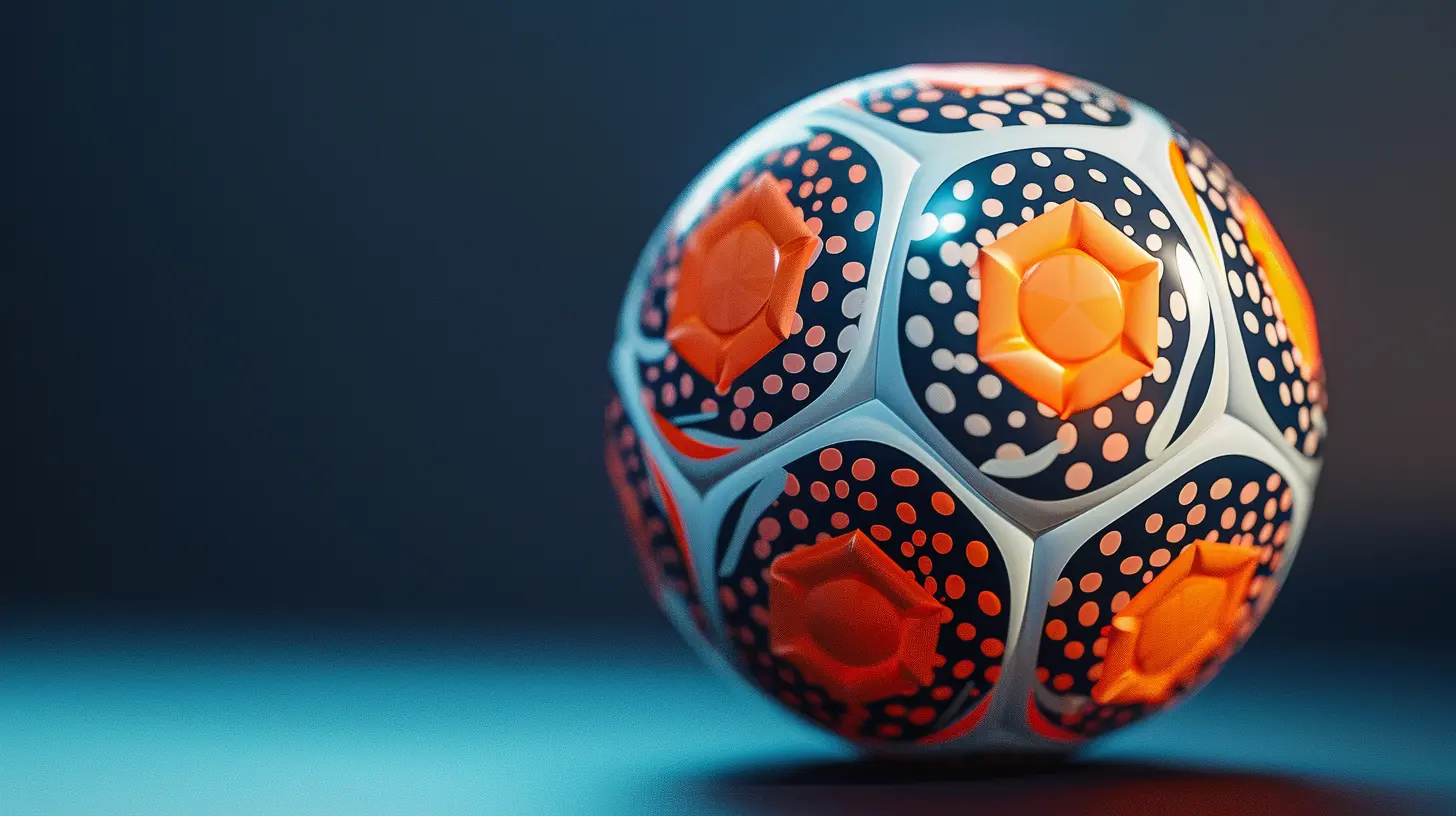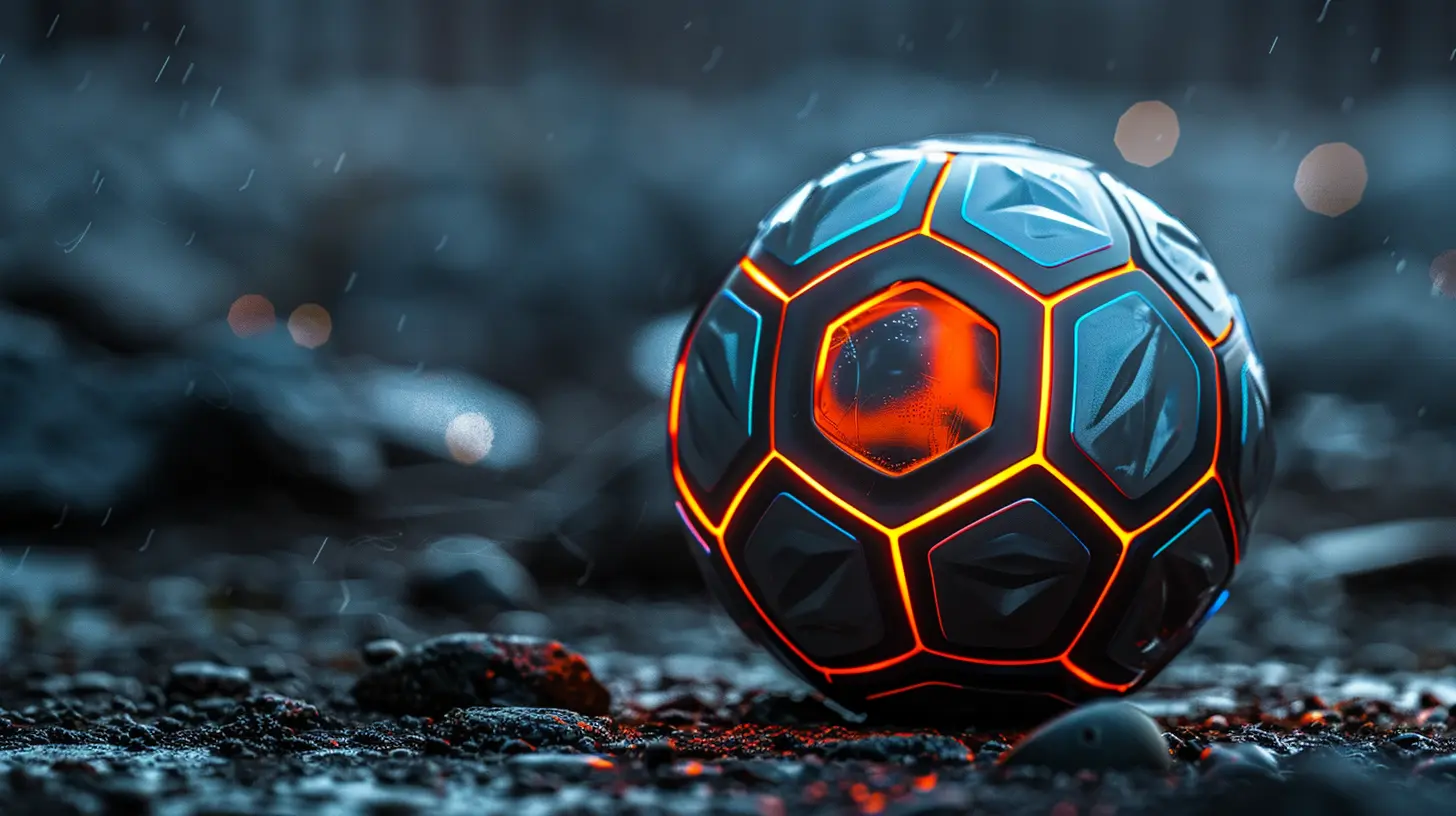The Science Behind High-Tech Soccer Balls
29 November 2024
When we think of soccer, we often focus on the players, the strategies, the goals, and the excitement of the game. But have you ever stopped to consider the ball itself? Soccer balls have come a long way from the simple leather or rubber spheres used in the past. Today, the world of soccer is dominated by high-tech soccer balls that are designed using advanced materials and cutting-edge technology. These modern soccer balls aren’t just aesthetically pleasing—they are engineered for precision, speed, and performance.
In this article, we'll dive into the science behind high-tech soccer balls, exploring how they’re made, why they’re so important, and how they impact the game. So, get ready to kick off this fascinating journey into the science that’s revolutionizing soccer equipment.

A Brief History of Soccer Balls
Before we get into the nitty-gritty science, it's worth taking a quick detour into the history of soccer balls. Back in the day, early soccer balls were made from animal bladders (yes, you read that right). They were then wrapped in leather to give them a better shape and durability. But these rudimentary balls were far from perfect—they were uneven, heavy when wet, and prone to losing their shape.Fast forward to the 20th century, and synthetic materials became the norm, replacing leather and leading to the creation of more consistent, durable soccer balls. But the real game-changer came in the 21st century, with the rise of high-tech soccer balls designed with precision and performance in mind.

The Anatomy of a Modern Soccer Ball
To understand the science behind high-tech soccer balls, we must first break down their construction. A typical high-tech soccer ball consists of several key components:1. Outer Cover
The outer cover is the first thing you notice when you pick up a soccer ball. It's the layer that makes contact with the players’ boots and the playing field. Modern soccer balls typically have a synthetic outer layer made from polyurethane (PU) or polyvinyl chloride (PVC). These materials offer excellent durability and water resistance, ensuring that the ball maintains its shape and performance even in wet conditions.2. Panels
Gone are the days of the classic 32-panel design. Today’s high-tech soccer balls feature fewer panels, often ranging from 6 to 12, depending on the manufacturer and design. Fewer panels mean fewer seams, resulting in a smoother surface and more consistent flight. This is particularly important for players who rely on precision when striking the ball.3. Bladder
Inside the soccer ball, you’ll find the bladder. This is the part that holds the air and gives the ball its bounce. Most high-tech soccer balls use latex or butyl bladders. Latex bladders offer better responsiveness and feel, making them popular among professional players. Butyl bladders, on the other hand, provide better air retention, so the ball stays inflated longer.4. Lining
Between the outer cover and the bladder, you’ll find multiple layers of lining, usually made from polyester or cotton. These layers provide structure and stability, ensuring the ball retains its shape and offers consistent performance over time. The number of lining layers can vary, with high-quality balls often featuring four or more layers for added durability and control.5. Stitching or Bonding
How the panels are held together plays a crucial role in the ball’s performance. Traditional soccer balls are stitched together, but many high-tech soccer balls now use thermal bonding. This process involves using heat to fuse the panels together, eliminating the need for stitches. Bonded balls have a smoother surface and are less likely to absorb water, making them more aerodynamic and reliable in wet conditions.
The Impact of Aerodynamics
One of the most critical factors in the performance of a soccer ball is its aerodynamics. When a player kicks a ball, its flight path is influenced by air resistance, spin, and the ball’s surface texture. High-tech soccer balls are designed with these factors in mind to ensure they move predictably and consistently through the air.1. Surface Texture and Panel Shape
The texture of a soccer ball's surface can significantly affect its aerodynamics. Traditional balls with stitched panels often had small grooves and seams that created turbulence in the air, causing unpredictable flight patterns. High-tech soccer balls, with their bonded panels and smoother surfaces, minimize turbulence, resulting in a more stable flight.Some modern soccer balls even feature micro-textured surfaces or dimples, similar to a golf ball. These tiny imperfections help reduce drag, allowing the ball to travel faster and more accurately over long distances.
2. Spin and the Magnus Effect
Have you ever seen a player bend the ball around a wall of defenders during a free kick? That’s the Magnus Effect in action. When a soccer ball spins, it creates a difference in air pressure on either side of the ball. This causes the ball to curve in the direction of the spin, whether it’s a gentle arc or a dramatic swerve.High-tech soccer balls are designed to maximize the Magnus Effect, making it easier for players to control the ball's spin and trajectory. The smooth surface and panel arrangement help maintain consistent airflow, giving players more precision when curving shots or passes.

Smart Soccer Balls: The Future of the Game
As if high-tech soccer balls weren’t advanced enough, we’re now entering the era of smart soccer balls. These balls incorporate sensors and electronics to track data in real-time and provide feedback on performance.1. Embedded Sensors
Smart soccer balls often feature embedded sensors that can measure various metrics, such as speed, spin, and impact force. Using these sensors, players can analyze their kicks in detail, helping them improve technique and monitor progress over time.These balls connect to mobile apps or devices via Bluetooth, allowing players and coaches to access data right on their smartphones. For instance, Adidas has developed a smart soccer ball called the miCoach Smart Ball, which uses sensors to provide detailed data on shot power, spin, and trajectory.
2. Training and Development
Smart soccer balls are revolutionizing player development. Coaches can now use data from these balls to tailor training sessions based on a player’s strengths and weaknesses. Players can also use the data to work on specific aspects of their game, such as improving their shot accuracy or increasing their kick power.While smart soccer balls are still relatively new, they’re quickly gaining popularity. As the technology becomes more affordable and accessible, we can expect to see more teams and players—both amateur and professional—using these high-tech tools to gain a competitive edge.
The Role of FIFA Standards
It’s one thing to design a high-tech soccer ball, but it’s another thing entirely to create a ball that meets the strict standards set by FIFA. The world’s governing body for soccer has a rigorous testing process to ensure that all official match balls meet specific criteria for weight, size, bounce, and water absorption.1. Weight and Size
According to FIFA regulations, a soccer ball must weigh between 410 and 450 grams (14 to 16 ounces) and have a circumference of 68 to 70 centimeters (27 to 28 inches). These standards ensure consistency across all matches, from local leagues to the World Cup.2. Bounce and Roundness
FIFA also tests the bounce and roundness of soccer balls to ensure they perform predictably during games. The ball must maintain its shape and bounce consistently, regardless of the conditions or how many times it’s kicked.3. Water Absorption
One of the biggest challenges for soccer balls is dealing with wet conditions. A ball that absorbs too much water becomes heavy and difficult to control. That’s why FIFA tests for water absorption, ensuring that modern soccer balls can handle wet weather without losing performance.
Conclusion: A Perfect Blend of Tradition and Technology
Soccer may be one of the oldest sports in the world, but the game is continually evolving. High-tech soccer balls represent the perfect blend of tradition and technology, combining the time-honored principles of ball design with cutting-edge materials and innovations.Whether you’re playing at the local park or watching a professional match, the ball at the center of the action is a marvel of modern engineering. From its aerodynamic design to the potential of smart technology, the soccer ball is no longer just a simple object—it’s a finely-tuned piece of sports equipment designed to enhance the beautiful game.
So the next time you see a player bend it like Beckham or fire a rocket into the top corner, remember that it’s not just the player’s skill at work—the science behind the ball is playing its part too.
all images in this post were generated using AI tools
Category:
Sports EquipmentAuthor:

Preston Wilkins
Discussion
rate this article
20 comments
Megan Kearns
Fascinating insights! Technology truly enhances the game!
April 5, 2025 at 8:58 PM

Preston Wilkins
Thank you! I'm glad you found the insights intriguing. Technology really is transforming the game!
Vanta Walker
Who knew soccer balls had PhDs? With all this high-tech wizardry, they might just start giving tactical advice on the pitch! ⚽️💡
March 23, 2025 at 5:26 AM

Preston Wilkins
Haha, right? The blend of technology and sport is truly fascinating—these smart soccer balls are redefining the game! ⚽️✨
Meagan McPhee
This article offers intriguing insights into how technology enhances soccer ball design, improving performance and precision. It’s fascinating to see how science plays a crucial role in the beautiful game. Great read!
February 10, 2025 at 7:38 PM

Preston Wilkins
Thank you for your feedback! I'm glad you found the connection between technology and soccer ball design intriguing. It's an exciting time for the sport!
Zephyrae Whitaker
In spheres of innovation, the beautiful game ascends, Precision and flight, where science and skill blend, Each kick ignites dreams, as boundaries transcend.
February 1, 2025 at 9:38 PM

Preston Wilkins
Thank you! I'm glad you enjoyed the blend of innovation and artistry in soccer. Your words beautifully capture the essence of the game's evolution!
Clarissa Adkins
This article astutely highlights the intersection of technology and sports, illustrating how advanced materials and design enhance performance, accuracy, and player safety. By exploring the engineering behind high-tech soccer balls, it sheds light on the future of athletic innovation.
January 28, 2025 at 5:13 AM

Preston Wilkins
Thank you for your insightful feedback! I'm glad you found the intersection of technology and sports compelling in the article.
Elowis McDonough
Embracing technology in soccer not only enhances performance but also sparks innovation in the game. High-tech soccer balls symbolize the perfect blend of tradition and progress, inspiring players to reach new heights. Let's kick off this exciting evolution!
January 23, 2025 at 4:08 AM

Preston Wilkins
Absolutely! Embracing technology in soccer not only elevates player performance but also drives innovation, making the game more dynamic and exciting. The evolution of high-tech soccer balls exemplifies this perfect blend of tradition and advancement.
Eliana McFarland
Loved this article! It’s fascinating how technology is transforming soccer balls to enhance gameplay. Who knew that the design and materials could impact everything from flight stability to player performance? Excited to see how these innovations will shape the future of the game! ⚽️
January 18, 2025 at 5:34 AM

Preston Wilkins
Thank you! I'm glad you found it fascinating. The advancements in soccer ball technology truly are changing the game in exciting ways! ⚽️
Daniella Barker
Who knew soccer balls had more gadgets than my old flip phone? Next thing you know, they'll be serving lattes and giving halftime pep talks! Can’t wait for the smart goalie gloves!
January 14, 2025 at 8:34 PM

Preston Wilkins
It's true! Technology is transforming sports, making them more engaging and insightful. Who knows what innovations we'll see next?
Dominique Frye
Revolutionizing play: technology meets tradition.
January 9, 2025 at 8:23 PM

Preston Wilkins
Thank you! It's exciting to see how technology enhances the traditional game, making play smarter and more accessible for everyone.
Zephyrian McClellan
Great article! It’s fascinating to see how technology enhances performance in soccer. Looking forward to seeing these innovations in action!
January 1, 2025 at 1:22 PM

Preston Wilkins
Thank you! I'm glad you enjoyed it. Exciting times ahead for soccer technology!
Benjamin Ellison
Unlocking the future of soccer—innovation and technology elevate the game to new heights!
December 26, 2024 at 8:36 PM

Preston Wilkins
Thank you! Exciting advancements are indeed transforming the game, making it more dynamic and engaging for players and fans alike.
Miriam Wood
This article insightfully explores how technology enhances performance and precision, revolutionizing the game for players and fans alike.
December 24, 2024 at 7:59 PM

Preston Wilkins
Thank you! I'm glad you found the article insightful. Technology truly is transforming the game for everyone involved!
Karly Walker
Fascinating intersection of technology and sport! Excited to see how this evolves gameplay!
December 21, 2024 at 1:27 PM

Preston Wilkins
Thank you! It's an exciting time for innovation in sports, and I'm eager to see how these advancements enhance the game!
Brianna Wells
Fascinating insights! It’s intriguing to see how technology enhances the game. I wonder how these advancements will impact player performance and the overall strategy of soccer in the coming years. Exciting times ahead!
December 11, 2024 at 8:04 PM

Preston Wilkins
Thank you! It’s definitely exciting to think about the potential impact of technology on player performance and strategies. The future of soccer looks promising!
Oliver Sweeney
Who knew soccer balls had more tech than my smartphone? Next thing you know, they’ll be giving post-match interviews and critiquing players’ footwork! Can’t wait for the day a ball wins the FIFA Ballon d'Or. Talk about a ‘kick’ in the right direction!" 🍕⚽️
December 5, 2024 at 9:20 PM

Preston Wilkins
Haha, right? Who knew tech could score such goals in the game! The future of soccer balls is definitely taking a fascinating turn! ⚽️✨
Kayla McVicker
This article brilliantly illuminates the fascinating technology behind modern soccer balls. From enhanced aerodynamics to advanced materials, the science truly revolutionizes the game. It's intriguing to see how innovation influences player performance and enhances the overall experience. A must-read for any soccer enthusiast eager to understand the game’s evolution!
November 30, 2024 at 11:27 AM

Preston Wilkins
Thank you for your thoughtful feedback! I'm glad you found the article insightful and that it highlighted the exciting advancements in soccer ball technology.
Alvin Malone
Great article! It’s fascinating to see how technology enhances the beautiful game. Excited to learn more about the innovations shaping soccer’s future. Keep up the fantastic work!
November 30, 2024 at 5:40 AM

Preston Wilkins
Thank you for your kind words! I'm glad you found it interesting. Stay tuned for more on the exciting innovations in soccer!
Keira Duke
This article effectively highlights the innovative engineering behind modern soccer balls, underscoring how materials and design enhancements improve performance and accuracy. By integrating technology with traditional gameplay, the evolution of soccer balls not only enhances player experience but also influences game outcomes at all levels.
November 29, 2024 at 8:24 PM

Preston Wilkins
Thank you! I'm glad you found the article insightful. The blend of technology and traditional play truly is fascinating and transformative for the game!
Rebecca Banks
High-tech soccer balls blend innovation and tradition, enhancing performance while preserving the game’s essence.
November 29, 2024 at 12:21 PM

Preston Wilkins
Thank you! It's exciting to see how technology can elevate performance while honoring the game's rich history.
Quade Duffy
This article brilliantly highlights the fascinating intersection of technology and sports! Understanding how high-tech soccer balls enhance performance really adds depth to our appreciation of the game. Excited to see how this evolves in future matches!
November 29, 2024 at 5:32 AM

Preston Wilkins
Thank you for your kind words! I'm glad you enjoyed the article and share the excitement about how technology is shaping the future of soccer.
MORE POSTS

The Importance of Emotional Intelligence in Sports Leadership

The Unwritten Rules: Acts of Sportsmanship That Transcend the Game

How Weather Conditions Impact Cricket Strategy and Performance

The Importance of Mental Toughness in High-Stakes Games

The Unsung Victories: How Sportsmanship Transforms the Sporting World

Beyond the Scoreboard: Stories of Honor and Respect in Sports

Breaking Down the Most Creative Attacking Plays of the Weekend

How to Use Off-the-Ball Movement to Set Up Scoring Chances

From the Pitch to the Court: Comparing Leadership Styles in Different Sports Leagues

How Sponsorship Deals Influence the Direction of Sports Leagues

The Impact of Franchise Leagues on International Cricket

How Streaming Services Are Changing the Way We Watch Leagues